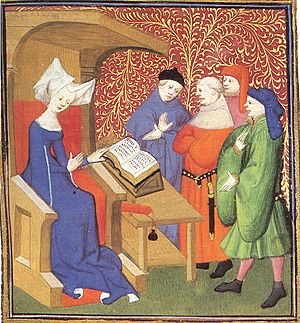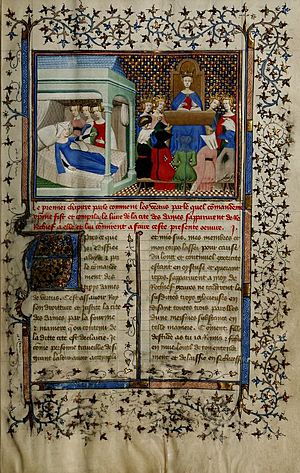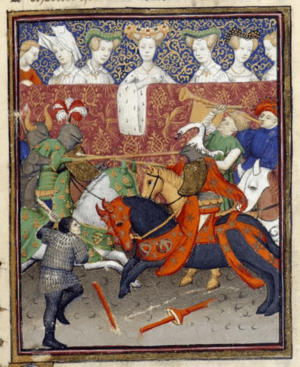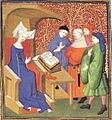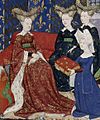Christine de Pizan facts for kids
Christine de Pizan (born Cristina da Pizzano) was an amazing writer from Italy. She lived from 1364 to about 1430. Christine became a famous poet and writer for King Charles VI of France and other important French leaders.
She worked as a court writer in medieval France after her husband passed away. Christine's supporters included dukes like Louis I of Orleans and Philip the Bold of Burgundy. Many people see her writings as some of the first ideas about women's rights. Her works include stories, poems, and biographies. She also wrote about history, philosophy, and politics. Her most famous books are The Book of the City of Ladies and The Treasure of the City of Ladies. These books gave advice to princesses, princes, and knights. They were popular for a long time.
Contents
Christine's Early Life
Christine de Pizan was born in 1364 in Republic of Venice, Italy. Her father, Tommaso di Benvenuto da Pizzano, was a doctor and astrologer. He was also a trusted advisor in Venice. In 1368, her father got a job with King Charles V of France. So, Christine moved to Paris when she was four years old.
In 1379, Christine de Pizan married Etienne du Castel. He was a royal secretary. They had three children together. Sadly, Christine's father died in 1388. Then, her husband died from the plague in 1389. This meant Christine had to take care of her mother and her children all by herself. She also had to deal with legal problems to get money from her husband's estate.
Becoming a Professional Writer
To support her family, Christine started writing for a living. By 1393, she was writing love poems. These poems caught the eye of rich people in the royal court. Christine became a very busy writer. She was involved in making her books. She also used her connections wisely during a time of political trouble. This made her the first professional woman writer in Europe.
Even though she was born in Venice, Christine loved France very much. She became close to the French royal family. She gave her early poems to important members of the family. These included Isabeau of Bavaria, the Queen, and Louis I, Duke of Orléans.
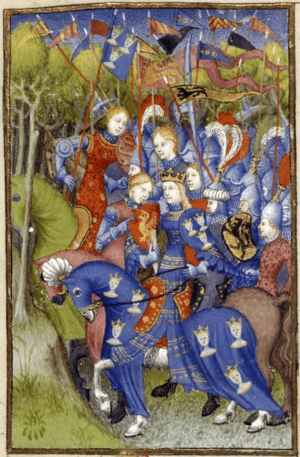
France was ruled by King Charles VI. He had mental health problems, which caused problems for the French government. The Queen, Isabeau, was in charge when her husband was sick. But she could not stop fights between members of the royal family. Christine wrote books about the good qualities of women. She mentioned Queen Blanche of Castile, who was a strong leader in the past. Christine dedicated these books to Queen Isabeau.
Christine believed that France was founded by people from Troy. She thought the royal family followed good leadership ideas. In 1400, Christine published L'Épistre de Othéa a Hector. This book was for Louis of Orléans, the King's brother. In the book, the goddess of wisdom, Othéa, teaches Hector of Troy how to be a good leader. Christine made beautiful, illustrated copies of this book. She also made special versions for other important people, like Philip the Bold and Henry IV of England.
In the Middle Ages, books were becoming more common. Royal families started to pay writers to create books for them. Christine worked for different parts of the royal family. She took on many paid projects at the same time. Then, she shared these works with other noble families in France.
In 1402, Christine got involved in a famous literary debate. It was called the "Querelle du Roman de la Rose." During the Hundred Years' War between France and England, Christine wrote Le Chemin de long estude in 1403. In this story, she travels with a wise woman. They see a debate about the world between four ideas: Wealth, Nobility, Chivalry, and Wisdom. Christine suggested that a single, good ruler could bring justice to the world.
In 1404, Christine wrote about the life of King Charles V. She showed him as a perfect king and leader. This book was called Le Livre des fais et bonnes meurs du sage roy Charles V. Philip the Bold of Burgundy asked her to write it. Christine also shared her thoughts on the royal court in the book. When Philip the Bold died, Christine offered the book to Jean, Duke of Berry. She received payments for her books from the court until 1412.
Important Books for Women
In 1405, Christine published two very important books. They were Le Livre de la cité des dames (The Book of the City of Ladies) and Le Livre des trois vertus (Book of Three Virtues). In The Book of the City of Ladies, Christine wrote about smart and powerful women leaders. One example was Queen Zenobia.
Christine dedicated Le Livre des trois vertus to the young princess Margaret of Nevers. She gave the princess advice on what she needed to learn. As Queen Isabeau's oldest son, Louis of Guyenne, grew up, Christine wrote three works for him. She wanted to help him become a wise and effective ruler. In Livre du Corps de policie (The Book of the Body Politic), published in 1407, Christine wrote about how societies should be governed. She thought that countries ruled by kings were better than those ruled by groups of people. She also wrote about the duties of a king as a military leader. She described the role of soldiers in society.
Civil War and Joan of Arc
France was close to a civil war starting in 1405. In 1407, John I of Burgundy caused a big problem. He ordered the killing of Louis of Orléans. John fled Paris, but later became a leader for King Charles VI. In 1410, Christine published a guide on chivalry and warfare. It was called Livre des fais d'armes et de chevalerie (The Book of Feats of Arms and of Chivalry). She wrote it in French so that soldiers who didn't know Latin could read it. The book talked about fair warfare. It also mentioned how to treat people who were not fighting and prisoners. Christine believed that God was in charge of battles. But she also knew that wars caused "many great wrongs" and killings. She said only kings should be allowed to start wars. This was because kings were responsible for their people.
After the civil war started in France, Christine wrote Livre de la paix (The Book of Peace) in 1413. This book gave advice to the young prince on how to rule well. It was Christine's last major work. She encouraged the prince to seek peace in France. She said, "Every kingdom divided in itself will be made desolate." Christine believed that peace and justice were possible on Earth. She told young princes to be kind, fair, and truthful.
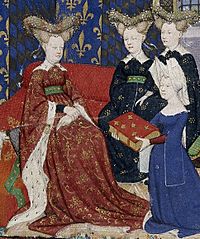
In 1414, Christine gave Queen Isabeau a beautiful collection of her works. This book had 30 of Christine's writings and 130 small pictures. Christine herself and her royal supporters are shown in these pictures. The first page shows Christine giving the book to Queen Isabeau.
In 1418, Christine published a book for women who had lost family members in the Battle of Agincourt. It was called Epistre de la prison de vie Humaine. In this book, Christine did not feel hopeful for peace on Earth. Instead, she felt that the soul was trapped in the body.
Historians think Christine spent the last ten years of her life in a convent. This was because of the civil war and the English taking over Paris. She stopped writing for a while. But in 1429, after Joan of Arc won a big battle, Christine wrote a poem. It was called Ditié de Jehanne d'Arc (The Tale of Joan of Arc). She wrote it just a few days after Charles VII became king. Christine felt hopeful again. She saw Joan as someone who fulfilled old predictions. Joan helped Charles VII become king.
Christine is thought to have died in 1430. This was before Joan of Arc was put on trial and executed by the English.
Christine's Works and Impact
Christine wrote many books and poems. Her works included political writings, letters, and poetry. In 1402, Christine wrote Le Dit de la Rose (The Tale of the Rose). This book directly criticized Romance of the Rose by Jean de Meun. Christine said that Meun's ideas were unfair to women. She started a debate about the book.
By 1405, Christine had finished her most famous books. These were The Book of the City of Ladies and The Treasure of the City of Ladies. The first book showed how important women's past contributions were. The second book taught women how to be good and useful.
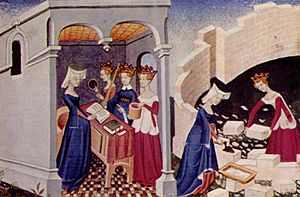
In The Book of the City of Ladies, Christine created a special city. In this city, women were respected and defended. She used three symbolic figures: Reason, Justice, and Rectitude. These figures were common in books of that time. Christine talked with these figures from a woman's point of view. They discussed important issues for all women. Only female voices and examples were used in this book. Christine argued that bad ideas about women could only continue if women were not allowed to speak up.
In City of Ladies, Christine thought about whether men and women had different good qualities. This was a common debate in medieval Europe. Christine often used the idea that men and women were both made in God's image. She said both had souls that could be good. The City of Ladies included female saints and good women from ancient times.
In The Treasure of the City of Ladies, Christine gave advice to all women. She wanted to teach them how to be good. She believed that all women could be humble, hardworking, and honest. She thought that with a good education, all women could be worthy citizens of her imaginary City of Ladies. Christine used her own life experiences to advise women. She taught them how to deal with challenges in 15th-century French society. She also gave advice on how noblewomen could love God. Christine used the figures of God's daughters – Reason, Rectitude, and Justice. These were the three most important qualities for women to succeed. Christine encouraged women to find meaning and do good things in their lives. She said that women's success depended on their ability to manage things and communicate well.
Christine even looked for other women to help her create her works. She specifically mentioned an artist named Anastasia. Christine said Anastasia was the most talented artist of her time.
Christine's Lasting Impact
Christine published 41 known works of poetry and prose during her life. She became famous across Europe as the first professional woman writer. Kings and queens asked her to write for them. Other smart people kept copies of her books in their libraries.
After she died in 1430, Christine's influence continued. Her writings remained popular. Her book The Book of the City of Ladies was still being printed in the 1500s. It was even translated into Dutch and English. Christine's Le Livre des trois vertus (The Treasure of the City of Ladies) became an important guide for royal women. For example, Anne of France, who ruled France for a time, used it for her own book of advice. Christine's advice for princesses was copied and shared among royal families. Other French women writers in the 1500s also mentioned Christine's City of Ladies.
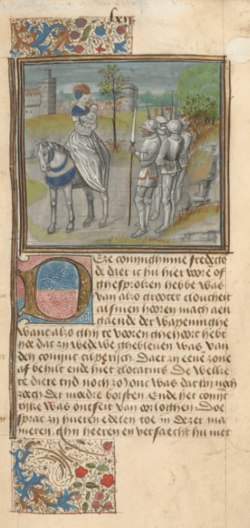
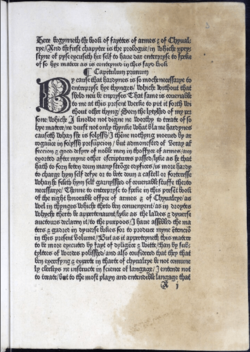
Christine's political writings also got attention. Her book Livre de la paix was mentioned by later thinkers. Her book on warfare, Livre des fais d'armes et de chevalerie, was printed in 1488. It was even translated into English by William Caxton for King Henry VII in 1489. Queen Elizabeth I of England had copies of Christine's books in her library. She even had tapestries with scenes from the City of Ladies.
For a while, Christine's political ideas were not as well known. But in the 20th century, scholars helped bring her work back into the spotlight. They showed that she was a very important writer.
Christine's ideas were similar to other popular writers of her time. But her strong defense of women was very unique. In her books, she stood up for women against writings that were unfair to them. These included books like Romance of the Rose. Her work has interested modern feminists. Simone de Beauvoir wrote in 1949 that Christine's Épître au Dieu d'Amour was the first time a woman wrote to defend her own gender.
The famous 1979 artwork The Dinner Party includes a special place setting for Christine de Pizan.
List of Christine's Works
- Enseignements moraux (1395)
- L'Épistre au Dieu d'amours (1399)
- L'Épistre de Othéa a Hector (1399–1400)
- Dit de la Rose (1402)
- Cent Ballades d'Amant et de Dame, Virelays, Rondeaux (1402)
- Le Chemin de long estude (1403)
- Livre de la mutation de fortune (1403)
- La Pastoure (1403)
- Le Livre des fais et bonnes meurs du sage roy Charles V (1404)
- Le Livre de la cité des dames (1405)
- Le Livre des trois vertus (1405)
- L'Avision de Christine (1405)
- Livre du corps de policie (1407)
- Livre des fais d'armes et de chevalerie (1410)
- Livre de paix (1413)
- Epistre de la prison de vie humaine (1418)
- Les sept psaumes allégorisés
- Ditié de Jehanne d'Arc (1429)
Images for kids
See also
Template:KIDDLE XL START  In Spanish: Christine de Pizan para niños Template:KIDDLE XL END
In Spanish: Christine de Pizan para niños Template:KIDDLE XL END
- Antoine Vérard
- List of French language poets
- Vernacular literature
- Women's history


